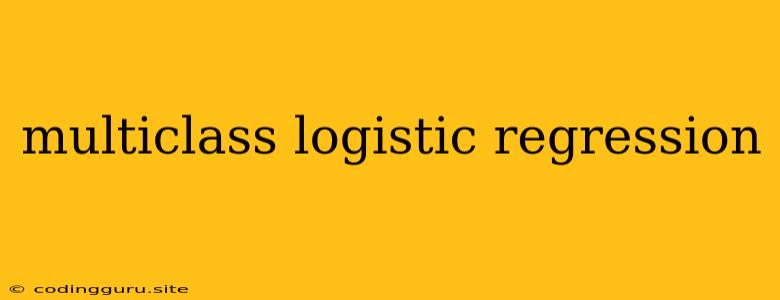What is Multiclass Logistic Regression?
Multiclass logistic regression is a powerful statistical technique used to predict the probability of an instance belonging to one of multiple classes. It's an extension of binary logistic regression, which can only predict between two classes. This makes it a versatile tool for a wide range of applications, from image classification and natural language processing to customer segmentation and medical diagnosis.
How does it work?
Multiclass logistic regression utilizes a generalized linear model to estimate the probability of each class for a given instance. This model incorporates a set of independent variables, each with its own weight, and applies a sigmoid function to transform the weighted sum into a probability.
The key is in the softmax function, a generalization of the sigmoid function, which takes the output of the linear model for each class and calculates the probability for each class. The sum of the probabilities for all classes always equals one.
When to use it?
Here are some scenarios where multiclass logistic regression proves to be a valuable tool:
- Predicting customer churn: Classify customers into different churn likelihood categories.
- Image classification: Assign images to specific categories like animals, objects, or landscapes.
- Natural language processing: Categorize text documents into different topics or sentiments.
- Credit risk assessment: Evaluate the likelihood of borrowers defaulting on loans.
- Medical diagnosis: Identify potential diseases based on patient symptoms and test results.
Steps for implementing multiclass logistic regression:
- Data Preparation: Ensure your data is clean, balanced, and features are properly encoded.
- Feature Selection: Choose relevant independent variables that contribute to the prediction of the dependent variable.
- Model Training: Utilize a statistical software package or library to train the model on the prepared data.
- Model Evaluation: Assess the model's performance using metrics such as accuracy, precision, recall, and F1 score.
- Model Deployment: Integrate the trained model into your application for real-time predictions.
Tips for successful implementation:
- Data quality: Ensure your data is accurate, complete, and free of errors.
- Feature engineering: Create new features based on existing ones to improve model performance.
- Model selection: Explore different algorithms and parameters to find the best performing model for your specific problem.
- Regularization: Implement regularization techniques to prevent overfitting.
- Cross-validation: Split your data into training and testing sets to ensure the model generalizes well to unseen data.
Example: Identifying Flower Species
Imagine you have a dataset of flower images, each with features like petal length, sepal width, and color. You want to build a model to predict the species of flower for a new image.
Multiclass logistic regression can be used to achieve this. You would first train the model using the labeled flower images and their corresponding features. Then, you can feed the features of a new image to the trained model, which will output the probability of the flower belonging to each species. The species with the highest probability is then predicted as the classification.
Advantages of Multiclass Logistic Regression:
- Interpretability: The model's coefficients provide insights into the relationship between features and the predicted classes.
- Scalability: It can handle large datasets and complex models efficiently.
- Widely applicable: Applicable to various domains with multiple class prediction problems.
Disadvantages of Multiclass Logistic Regression:
- Data requirements: Requires a large amount of labeled data for training.
- Linearity assumption: Assumes a linear relationship between features and the logit function.
- Overfitting: Prone to overfitting if not regularized properly.
Conclusion:
Multiclass logistic regression is a powerful and widely used technique for predicting the probability of an instance belonging to one of multiple classes. Its ability to handle complex relationships between features and classes, coupled with its interpretability and scalability, makes it a valuable tool for various applications. However, it is important to understand its limitations and ensure proper data preparation and model selection for optimal results.
